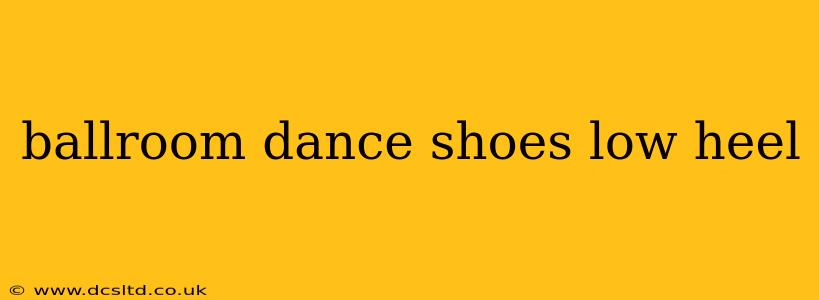Choosing the right ballroom dance shoes is crucial for comfort, performance, and preventing injuries. While high heels are iconic in ballroom, low-heeled options offer significant advantages for many dancers, particularly beginners or those seeking greater stability and comfort. This guide explores the world of low-heeled ballroom dance shoes, addressing common questions and concerns.
What are the benefits of low-heeled ballroom dance shoes?
Low-heeled ballroom dance shoes offer several key advantages:
-
Increased Stability: The lower heel provides a wider base of support, enhancing balance and reducing the risk of falls, especially beneficial for beginners learning complex steps. This stability translates to more confidence and smoother execution of movements.
-
Enhanced Comfort: Many dancers find low heels significantly more comfortable for extended periods of practice and performance. Reduced pressure on the balls of the feet and ankles leads to less fatigue and pain.
-
Greater Flexibility: A lower heel allows for a more natural range of motion in the ankles and feet, facilitating easier transitions between dance positions and steps.
-
Improved Posture: While high heels can encourage an unnatural posture, low-heeled shoes allow for a more natural and balanced stance, promoting better alignment and reducing strain on the back and neck.
Are low-heeled ballroom dance shoes suitable for all dance styles?
While traditionally associated with high heels, many ballroom dance styles can be successfully performed in low-heeled shoes. Styles like American Smooth (Waltz, Foxtrot, Viennese Waltz) and American Rhythm (Rumba, Cha-Cha, East Coast Swing) are often performed with varying heel heights, including low heels. However, some styles like International Standard (Waltz, Tango, Viennese Waltz) might favor a higher heel for specific stylistic elements. Ultimately, the suitability depends on personal preference, dance style, and comfort level.
What materials are typically used in low-heeled ballroom dance shoes?
Similar to their high-heeled counterparts, low-heeled ballroom dance shoes utilize a variety of materials:
-
Leather: A classic choice, offering breathability, flexibility, and durability. Leather shoes often require a break-in period for optimal comfort.
-
Suede: Provides excellent grip on the dance floor, crucial for precise movements and spins. Suede shoes often require more care and cleaning.
-
Synthetic Materials: More affordable options, offering decent durability and comfort. However, they may not offer the same breathability or longevity as leather.
The choice of material often depends on personal preference, budget, and the specific needs of the dancer.
Where can I find low-heeled ballroom dance shoes?
Low-heeled ballroom dance shoes are available from various retailers, both online and in physical stores specializing in dancewear. Many manufacturers offer customizable options allowing dancers to specify heel height and other features. It's recommended to try on shoes before purchasing to ensure proper fit and comfort.
How do I choose the right size for low-heeled ballroom dance shoes?
Proper sizing is crucial for comfort and performance. It is strongly recommended to try shoes on in a store. Be aware that dance shoe sizing might differ from standard shoe sizing. Consider taking measurements of your feet and consulting size charts from different manufacturers before purchasing online. Many manufacturers offer a variety of widths, allowing for a more precise fit.
What are some popular brands of low-heeled ballroom dance shoes?
Several reputable brands offer a range of low-heeled ballroom dance shoes. Researching specific brands and reading reviews can help you find a pair that meets your needs and preferences. Remember that the best brand will depend on your individual foot shape, dance style, and budget.
This guide provides a comprehensive overview of low-heeled ballroom dance shoes. Remember that finding the perfect pair often requires trying on different styles and brands to determine what best suits your individual needs and preferences. Happy dancing!
